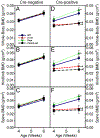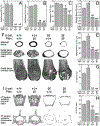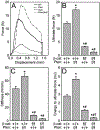Pten deletion in Dmp1-expressing cells does not rescue the osteopenic effects of Wnt/β-catenin suppression
- PMID: 32529635
- PMCID: PMC7529875
- DOI: 10.1002/jcp.29792
Pten deletion in Dmp1-expressing cells does not rescue the osteopenic effects of Wnt/β-catenin suppression
Abstract
Skeletal homeostasis is sensitive to perturbations in Wnt signaling. Beyond its role in the bone, Wnt is a major target for pharmaceutical inhibition in a wide range of diseases, most notably cancers. Numerous clinical trials for Wnt-based candidates are currently underway, and Wnt inhibitors will likely soon be approved for clinical use. Given the bone-suppressive effects accompanying Wnt inhibition, there is a need to expose alternate pathways/molecules that can be targeted to counter the deleterious effects of Wnt inhibition on bone properties. Activation of the Pi3k/Akt pathway via Pten deletion is one possible osteoanabolic pathway to exploit. We investigated whether the osteopenic effects of β-catenin deletion from bone cells could be rescued by Pten deletion in the same cells. Mice carrying floxed alleles for Pten and β-catenin were bred to Dmp1-Cre mice to delete Pten alone, β-catenin alone, or both genes from the late-stage osteoblast/osteocyte population. The mice were assessed for bone mass, density, strength, and formation parameters to evaluate the potential rescue effect of Pten deletion in Wnt-impaired mice. Pten deletion resulted in high bone mass and β-catenin deletion resulted in low bone mass. Compound mutants had bone properties similar to β-catenin mutant mice, or surprisingly in some assays, were further compromised beyond β-catenin mutants. Pten inhibition, or one of its downstream nodes, is unlikely to protect against the bone-wasting effects of Wnt/βcat inhibition. Other avenues for preserving bone mass in the presence of Wnt inhibition should be explored to alleviate the skeletal side effects of Wnt inhibitor-based therapies.
Keywords: Akt; Pten; Wnt; osteoporosis; β-catenin.
© 2020 Wiley Periodicals LLC.
Figures






References
-
- Bononi A, Bonora M, Marchi S, Missiroli S, Poletti F, Giorgi C, … Pinton P (2013). Identification of PTEN at the ER and MAMs and its regulation of Ca(2+) signaling and apoptosis in a protein phosphatase-dependent manner. Cell Death Differ, 20(12), 1631–1643. doi:10.1038/cdd.2013.77 - DOI - PMC - PubMed
-
- Brault V, Moore R, Kutsch S, Ishibashi M, Rowitch DH, McMahon AP, … Kemler R (2001). Inactivation of the beta-catenin gene by Wnt1-Cre-mediated deletion results in dramatic brain malformation and failure of craniofacial development. Development, 128(8), 1253–1264. - PubMed
Publication types
MeSH terms
Substances
Grants and funding
LinkOut - more resources
Full Text Sources
Medical
Molecular Biology Databases
Research Materials

